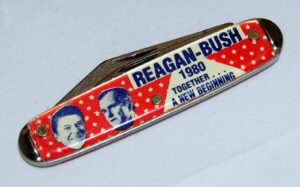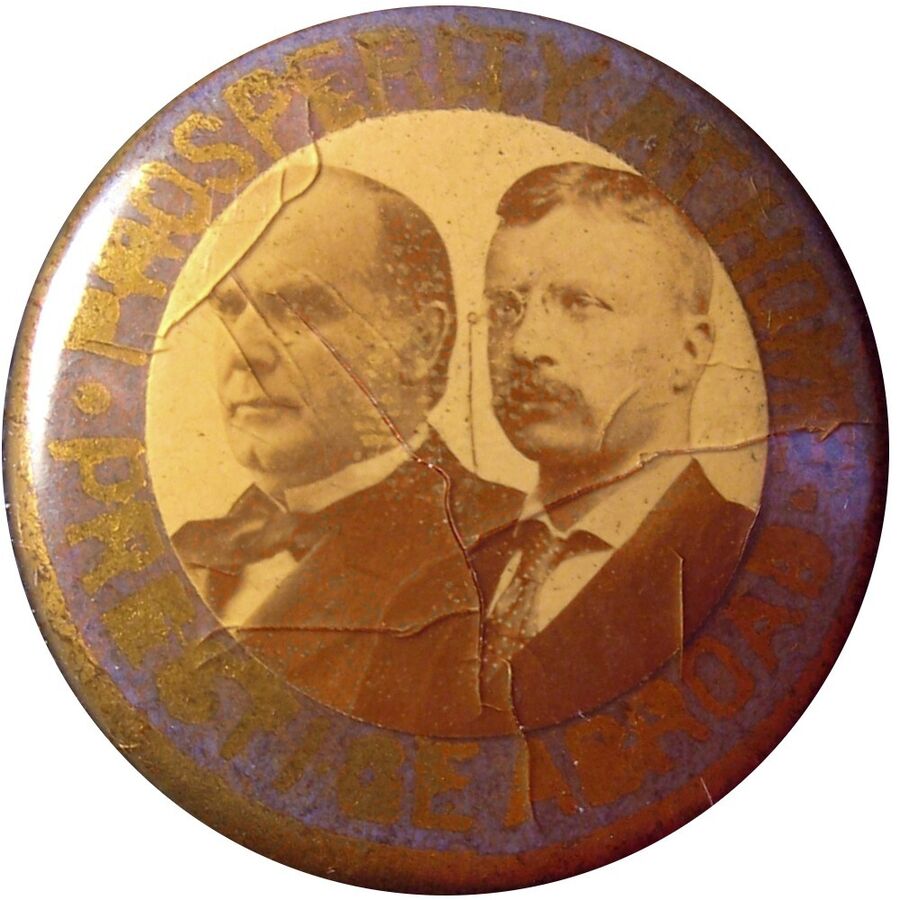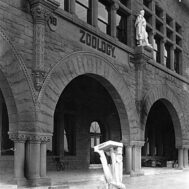
1864 John Fremont Political Campaign Token, public domain USA. Fremont was the first Republican Party presidential candidate. He was a an explorer, frontiersman and soldier. He lost to James Buchanan in a notably dirty campaign.
Nelson has been selling political memorabilia for decades having gotten the bug during the turbulent campaigns of the 1960s. Like the field itself, Nelson’s interest started as an adjunct to numismatics. Nelson first worked as a coin dealer at a concession owned by the Friedberg family in the Woodward and Lothrop Department Store at 10th, 11th, F and G Streets in Washington, DC. After that arrangement with Woodies ended, Nelson took over the Friedberg family’s business in Washington and moved the inventory to a nearby office building. Although Nelson still sells numismatic items, our nation’s Capital was the perfect place for him to build a business focusing on buying and selling political memorabilia.
Political memorabilia has been collected for as long as the American Republic has existed. Like all memorabilia, it reflects the times in which it was produced. That is certainly the case with the first American political keepsake, which is directly associated with George Washington, our first president. As the “father of our country,” Washington had such a sterling reputation that our first presidential election was not disputed. Instead, the electors under our new Constitution simply acclaimed Washington as the winner of an uncontested election. So, it’s no surprise that this earliest American political memorabilia is not from any “campaign.” Rather, in a nod to Washington’s victorious military career, a number of manufacturers produced high quality military style uniform buttons to commemorate his first inauguration. These buttons, which are found in copper or pewter and which sometimes show evidence of gilding, incorporate a variety of designs including the initials, “GW,” slogans like “Long Live the President” or images of Washington, eagles or sunburst designs. Today, surviving examples can fetch from $2,500 to $6,000 or more apiece.

Thomas Hisgen and John Graves Political campaign token 1908, public domain USA. The NYTimes header for a 7-29-1908 article read, “HISGEN AND GRAVES NEW PARTY TICKET; The Independence Convention Makes Its Choice in Early Morning. BRYAN’S NAME WAS HISSED Small Riot Followed Attempts to Nominate Him and His Sponsor Was Threatened by Delegates.”
Inaugural commemoratives remain popular, though uniform buttons have given way to everything from shot glasses to golf balls. Still, since the late 19th century, medals in bronze, silver or even gold have become the most recognized inaugural keepsakes. Of these, noted American sculptor Augustus Saint Gaudens created one of the most desirable examples for Teddy Roosevelt’s second inauguration in 1905. That beautifully executed medal features Roosevelt’s bust on the obverse along a powerful standing eagle design derived from ancient Greek coins of the Ptolemaic and Seleucid Empires on the reverse. Tiffany and Company produced only 150 examples, presumably to be distributed to Roosevelt’s closest supporters. The artistic design reflected the ethos of wealthy progressives of the day. Saint Gaudens engraved “AEQVVM CVIQVE” in Latin or “to each what is equitable” next to Roosevelt’s portrait. This motto evidently derives from Roosevelt’s campaign slogan of “a square deal for every man,” but it is rendered in a language only intelligible to TR’s most educated supporters.
The design was so well received that the eagle reverse was later reused for a US $10 gold piece, another item most likely to pass through the hands of our nation’s elites. Saint Gauden’s medal remains a luxury item today. An example sold at a Stacks Bowers auction in 2021 for $57,600. Since Roosevelt’s administration, inaugural medals of varying artistic quality have been struck every four years. Most remain readily available at much more reasonable prices. Oddly, President Trump, who is not known for his modesty, is the only modern Chief Executive who did not commission an official medal for his own inauguration.
Before any inauguration, a presidential candidate must first be elected, often only after a hotly disputed contest. Such contested elections have prompted the creation of all sorts of campaign materials aimed at getting out the vote, particularly as suffrage was gradually extended first to the landless, and then to minorities and women. In an era before mass entertainment, mid-19th and early 20th century campaigns often drew large crowds for speeches, rallies and nighttime torch-light parades. Such popular events inspired the creation of banners, flags, decorative torches and lanterns for use during the festivities. In addition, campaigns distributed ribbons, pins, badges and buttons to be worn by prospective voters so they could demonstrate their allegiance to their chosen candidate.

1904 Alton B. Parker and Theodore Roosevelt “flipper” campaign token with a competing candidate on each side. The token could be “flipped” by an undecided voter to choose the candidate to vote for. Public domain.
The advent of photography in the mid-1800’s prompted the production of “ferrotypes” and “tintypes” featuring images of the candidates. In the early 20th century, the use of celluloid led to the creation of the modern campaign button, which immediately became the most popular campaign souvenir. Today, such campaign buttons, as well as literature, signs, hats, bumper stickers, and tee shirts publicizing a candidate or cause, remain popular, but campaigns have largely shifted to digital advertising. As a result, the number of campaign give aways have diminished with such items now more often being sold to raise funds rather than distributed free to stimulate excitement with prospective voters.
Of course, there remains plenty for collectors to buy from past campaigns. There are almost as many ways to collect political memorabilia as there are objects on the market. Some collectors focus on particular periods, like the early 19th century. Others focus on third parties, particular causes or local candidates and elections. Still others only buy certain types of collectibles like ferrotypes or inaugural medals. Give aways from the White House or Air Force One or “challenge coins” distributed after foreign junkets are also popular. Sometimes collectors even buy personal items associated with famous political leaders. For example, Nelson has told the story of how he once bought and resold luggage owned by former President Eisenhower which had been rescued from the trash.

Reagan-Bush Pocket Knife, 1980, photo by Joe Haupt, 20 April 2015, CCA-SA 2.0 Generic License.
Collectors of campaign memorabilia must face the familiar problem of fakes and alterations. Indeed, the issue troubled the founders of the American Political Items Collectors (APIC) club so much that they were instrumental in convincing Congress to pass the “Hobby Protection Act” to help address such problems.[2]
With the advent of eBay and sales over the Internet, it is now easier than ever to purchase political memorabilia. Nevertheless, those who join AIPIC and participate in their shows will benefit not only from engaging with other collectors but learning more about the field from experts. And, of course, if you enjoy learning more about campaign souvenirs from a knowledgeable dealer, Nelson will always be there at his store the next time you are visiting our nation’s Capital.
Next Installment: What the Heck Is It?
Further Reading:

United States Centennial Ribbon, 1876, Susan H. Douglas Political Americana Collection, #2214, Cornell University. No known copyright restrictions.
From the Website of the American Political Items Collectors (APIC):
What should you collect?, American Political Items Collectors (undated), available at https://apic.us/what-should-you-collect (last visited September 18, 2024).
Glossary of Terms, American Political Items Collectors, available at: https://apic.us/glossary-of-terms (last visited September 18, 2024).
APIC also publishes a monthly newspaper called the “the Political Bandwagon” which is full of articles as well as information for collectors about upcoming shows.
From the Internet:
Benny Brandvold MD, Thoughts on Regional Scarcity of Political Campaign Material; “fish where the fish are, ” Montana and Presidential Election Memorabilia website, (last visited September 18, 2024).
Raymond M. Farina, Collecting Political Memorabilia, Journal of Antiques and Collectibles (undated), (last visited September 18, 2024).
David Seideman, Collecting Democracy, Intelligent Collector (Heritage Auction House, undated), (last visited September 18, 2024).
Theodore Roosevelt Special Inaugural Medal, the MET website, (last visited September 18, 2024).
Theodore Roosevelt 1905 Inaugural Medal, Stacks Bowers November 21, 2021 Baltimore Auction Lot 1047, (last visited September 18, 2024).
Nelson’s Shop

1885 Ulysses S. Grant Memorial Token, Gen. U.S. Grant. Saviour Of Our Stars And Stripes Fort Donelson 1862 Vicksburg 1863 Richmond 1865 President 1869 Born 1822 Died 1885 (50-75)
Capitol Coin, https://capitolcoin.com/
Reader Comments on the Woodward & Lothrop Store Coin Department, E-Sylum(6/5/2011), available on the Newman Numismatic Portal at the Washington University of Saint Louis (last visited September 18, 2024).
[1] Peter K. Tompa is a semi-retired lawyer who resides in Washington, D.C. He has written extensively about cultural heritage issues, particularly those of interest to the numismatic trade. Peter contributed to Who Owns the Past?” (K. Fitz Gibbon, ed. Rutgers 2005). He formerly served as Executive Director of the Global Heritage Alliance and now is a member of its Board of Directors. He currently serves as the Executive Director of the International Association of Professional Numismatists. This article is a public resource for general information and opinion about cultural property issues and is not intended to be a source for legal advice. Any factual patterns discussed may or may not be inspired by real people and events. The opinions stated in this article are the author’s alone and should not be attributed to any affiliated organization.
[2] The Hobby Protection Act is a consumer protection law that prevents the production and sale of imitation political and numismatic items that are not clearly marked. The law was signed into law on November 29, 1973, and is codified in 15 U.S.C. §§ 2101-2106. The Federal Trade Commission (FTC) is responsible for enforcing the law and creating rules and regulations to implement it.
 1900 William McKinley and Theodore Roosevelt, public domain. celluloid pin citing to prosperity at home and prestige abroad. McKinley was the last president to have served in the American Civil War. He served as a Congressman and then Governor of Ohio. Elected President in 1896 and 1900, he was assassinated in 1901. VP Theodore Roosevelt succeeded him and subsequently won re-election in his own right.
1900 William McKinley and Theodore Roosevelt, public domain. celluloid pin citing to prosperity at home and prestige abroad. McKinley was the last president to have served in the American Civil War. He served as a Congressman and then Governor of Ohio. Elected President in 1896 and 1900, he was assassinated in 1901. VP Theodore Roosevelt succeeded him and subsequently won re-election in his own right. 

